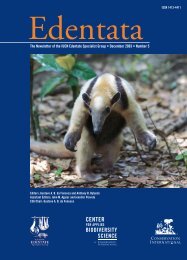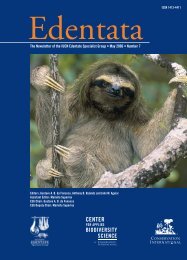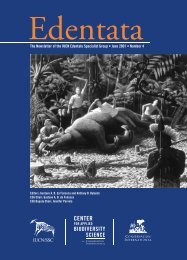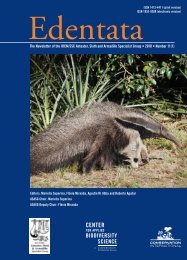Edentata 11(2), 2010 - Anteater, Sloth & Armadillo Specialist Group
Edentata 11(2), 2010 - Anteater, Sloth & Armadillo Specialist Group
Edentata 11(2), 2010 - Anteater, Sloth & Armadillo Specialist Group
- No tags were found...
You also want an ePaper? Increase the reach of your titles
YUMPU automatically turns print PDFs into web optimized ePapers that Google loves.
Letter from the EditorsThe IUCN/SSC <strong>Anteater</strong>, <strong>Sloth</strong> and <strong>Armadillo</strong> <strong>Specialist</strong> <strong>Group</strong>’s primary responsibility is to keep the IUCNRed List of Threatened Species up to date. The conservation status of all xenarthrans needs to be assessed ona regular basis to ensure it accurately reflects the latest scientific knowledge on their range, population trends,and threats. The last evaluation had been performed in December 2004, during the Edentate Species AssessmentWorkshop in Belo Horizonte, Brazil (see <strong>Edentata</strong> 6). We therefore considered it necessary to re-assess allxenarthrans.As a first step, we organized a meeting during the 10 th International Mammalogical Congress (IMC10), whichwas held in August 2009 in Mendoza, Argentina. It was exciting to see that the group of Xenarthra researchersand enthusiasts is steadily growing! Over 30 researchers and graduate students from ten countries providedinvaluable information that allowed us to update the range maps and carry out the re-assessment.The conservation status of all 21 armadillo species was re-evaluated in December 2009. The anteaters and slothsfollowed in May and June <strong>2010</strong>. The species descriptions were updated in IUCN’s Species Information System(SIS), a new web-based application for managing species information that is at the core of the IUCN Red Listof Threatened Species. This application allows swift updates, ensures consistent application of the Red List Categoriesand Criteria, and facilitates the evaluation process. Each assessment was then checked for consistencyby two evaluators. The criteria, as well as the specific terminology used for the assessment, are explained in theglossary at the end of this special issue of <strong>Edentata</strong>.Two sloths, one anteater and four armadillos are now listed in a threatened category. Bradypus pygmaeus, themost threatened xenarthran, has been categorized as Critically Endangered, while B. torquatus is classified asVulnerable. Four armadillo species are listed as Near Threatened, while four are insufficiently known to beassessed and are therefore listed as Data Deficient. The isolated population of Cyclopes didactylus that inhabitsthe Atlantic forest of coastal northeastern Brazil was assessed separately and classified as Data Deficient. Fiftypercent of all xenarthrans are considered Least Concern.The updated armadillo assessments are available on the IUCN Red List of Threatened Species website (). The anteater and sloth assessments have been submitted to the IUCN/SSC and are currentlybeing reviewed by the Red List authorities. They will be available online in May or June 20<strong>11</strong>.We are very grateful to the 39 researchers who actively participated in the 2009/<strong>2010</strong> Xenarthra assessment. Thisevaluation would not have been possible without their collaboration, and we hope that all Xenarthra researcherswill continue sharing their field observations and publications with us to keep the Red List up to date.Mariella Superina Flávia Miranda Agustín M. AbbaChair Deputy Chair Red List Authorityii<strong>Edentata</strong> no. <strong>11</strong>(2) • <strong>2010</strong>














